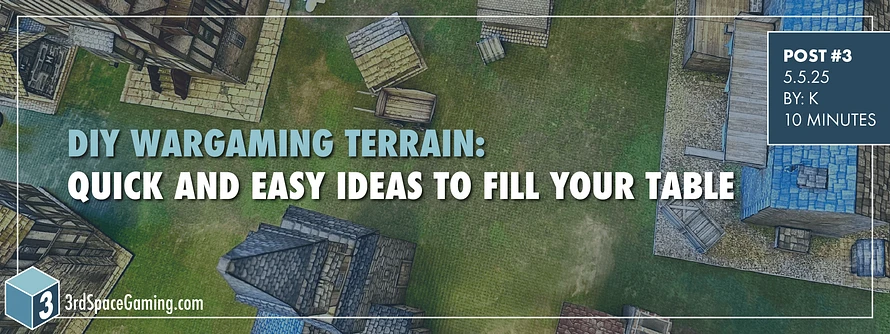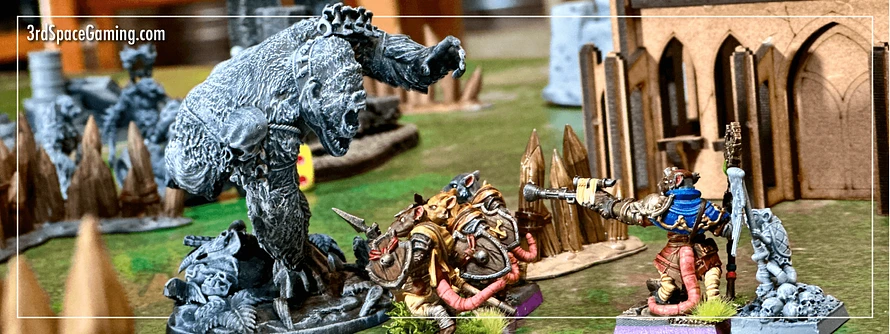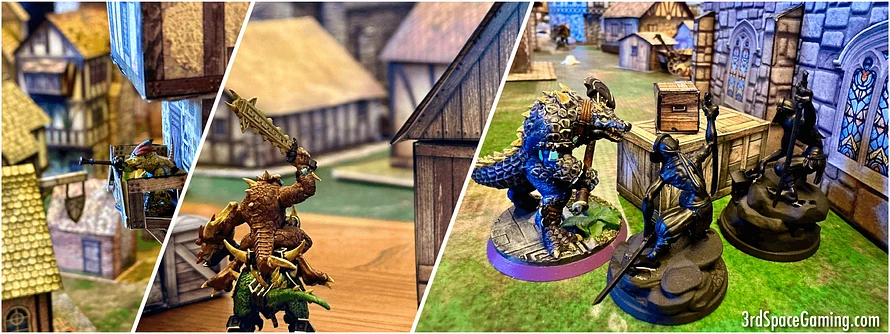DIY Wargaming Terrain: Quick and Easy Ideas to Fill Your Table

Terrain is essential to any tabletop wargame and can be successfully incorporated into many different RPGs. Whether you're battling across a dystopian cityscape in Warhammer 40K or exploring barren deserts in Pathfinder, terrain increases the immersion and adds strategic elements to your games. But sometimes filling up your gaming table can feel daunting and expensive. Unfortunately, store-bought terrain can be costly, and crafting your own from scratch can feel intimidating. Don’t fret, because we’ve got you covered. In this guide, we’ll teach you how to have fun and get the most out of your DIY terrain, from basic principles to suggested materials and a dash of inspiration.
Crafting terrain in and of itself can be a fun and rewarding project. So it is important to remember that not everything needs to be rushed. Sometimes the enjoyment is in the process and the journey. Building your own terrain also allows you to incorporate storytelling elements and threads that enrich the world:
- Rival gang’s graffiti tags on shipping containers.
- Battle damage and blood splatter at an outpost.
- Or a campsite gone cold.
They are all small additions that help build the back story and establish the setting.
That said, not everything needs to be overly complicated or pretentious. Sometimes you just want to get together with friends, roll some dice, and bash some baddies. That’s why it is important to stop and think about what you enjoy in your gaming experience. Hyper-competitive tactical gameplay where millimeters matter? That’s rad. Casual hangout with friends and minimal prep? That’s also rad. So find what’s rad for you and prioritize that.
It’s also ok if you don’t enjoy crafting terrain from scratch. Personally, that is one of my favorite parts of the hobby, but I have some friends who don’t bother with it at all. And that’s ok, because they know what they like and don’t like. If you aren’t into the crafting aspects, then your goal is just to get the table filled up adequately enough to set up your minis and roll some dice. In that case, we still have you covered with some easy ideas of items already around your home.
Let’s get into it!
KEY CONCEPTS AND OBJECTIVES
Before we jump into what to build or how to build it, let’s first start with the basics, like why we need terrain and what we should focus on when setting up a board.
Apart from the basics of “it looks cool”, terrain is responsible for three main things:
- Changing up the elevation and height on the board
- Providing cover and limiting line of sight
- Adding in points of interest and narrative hooks
Changing up the elevation is important from both a strategic perspective and a narrative one. If the board is flat and featureless, then that hardly creates an immersive experience. It also doesn’t allow ranged characters like archers, snipers, or spell slingers the ability to flex their prowess. So be sure to create little places throughout the board that will allow ranged units to get a bird's eye view. Hills, plateaus, and the like are also great for creating defensive positions where melee units can valiantly defend the high ground until the last.
Now that you have added in some high ground and sniper nests, it is essential to provide some cover for units to cower in the shadows. Limiting line of sight and funneling characters into fire alleys is especially important in modern or sci-fi games where the majority of the characters have some form of ranged attack. Add in some easily defensible positions and some choke points throughout the map for some exciting encounters.
If you are playing a symmetrical battle, be sure to give equal terrain elements on either side. Terrain can give an unfair advantage or give certain armies the upper hand, but that can also be used intentionally for certain game modes. King of the hill, defend the fort, and infiltration are all game types that encourage asymmetrical gameboards and can have some surprising and unexpected game moments.
Landmark terrain and points of interest are one of the easiest and most rewarding ways to introduce or reinforce narrative elements.
“Go stand over there and fight the enemy” is much less engaging than “You are the last remaining company on the planet that has been invaded by an alien force. You must reach the communication outpost and secure it for 3 rounds in order to send out an SOS message to the nearest allied fleet.”
Establishing narrative hooks like this that incorporate terrain pieces not only increases the immersion but also helps craft a compelling backstory for why this particular battle is taking place and raises the stakes for all the players. And it doesn’t take all that much extra effort, just a couple quick sentences to establish why this matters and what winning will mean for each side.
FOUNDATIONAL DESIGN ELEMENTS
If you’re just starting out on your terrain-building journey or looking to augment an existing collection, it’s always important to remember not to let perfection get in the way of good. This is one trap that I personally fell into at the start. Every piece of terrain had to be perfect. I would pour dozens of hours into a single piece that was expertly crafted and chock-full of tiny details. But when it came to game time, I noticed that often the pieces that I slapped together the quickest got the most compliments. That’s why it is good to keep the law of diminishing returns in mind. Meaning: if you spend one hour on something and get a good result, spending ten hours on that same thing won’t necessarily get you a result that is ten times better. And like I said above, crafting terrain is one of my favorite aspects of the hobby, so the act of creating was rewarding for me, but if you are trying to get a board game ready as quickly as possible, don’t dump 10 hours into something when you can effectively get something table ready in an hour or two.
That’s where terrain crafting turns into a delicate balancing act. Sometimes it is better to build ten things that are just ok, rather than building one perfect piece. When working on a single piece, it is easy to get tunnel vision, but keep in mind that the end goal is having a complete board to be viewed as a whole that is usually greater than the sum of its parts. This is because scope and scale work in your favor. The same concept applies to painting miniatures. If you look at a single model in isolation, then the sloppy lines or crossed eyes are obvious, but once you zoom out and put that same model in its place with the rest of the troops on a full board, it looks impressive. Similarly, all of the small imperfections in your terrain start to melt away as soon as the board starts to fill up.
In the same vein, it is usually most time effective to “min/max” with certain pieces. No matter how many hours you put into a shipping container, it will still just be a shipping container. So don’t bash your head against the wall trying to make it a work of art. But if you are making a center piece or a map for the final big bad boss battle of a long campaign, then it might warrant some extra TLC. Understanding where everyone’s focus and attention will be placed will also help you determine the best use of your time. It is also possible to steer people’s attention where you want it. Spent a couple of extra hours painting a computer screen that you’re really proud of? Make sure that it is the narrative focus for the battle to give it the attention it deserves.
PRACTICAL DESIGN CONCEPTS
Now that we talked through some of the more philosophical design elements, let’s address two of the more practical design concepts:
- Keep it light
- Make it versatile
I’ve spent countless hours working on terrain pieces that have never once been used. Why? Because I forgot that after I’ve completed the piece on my work desk, I need to be able to transport it easily. That’s why it is key to keep things light and relatively simple. What do I mean by simple? Don’t have a bunch of fragile thingies and widgets sticking off of your terrain because they will inevitably get broken off at some point. If you are lucky enough to have a dedicated gaming space where you don’t need to pack up and move your terrain, then it’s ok, go wild and make the most intricate, ornate building imaginable. But for the rest of us who need to pack our terrain away into a cardboard box for transport and storage between gaming sessions, keep it light and keep it simple.
This brings me to the second point. When I got back into Warhammer and One Page Rules, I wanted to play both Sci-Fi and fantasy games. This meant that I effectively needed to build up two sets of terrain, which felt like a huge undertaking. So instead of building out two completely separate boards, at first I focused on terrain pieces that could fit both genres. Physical terrain features like rocks, hills, and river beds are the easiest to translate between genres. Luckily, these are also some of the terrain pieces that are big and help to fill up a game board quickly. After I had a good assortment of multipurpose pieces, that's when I focused on a couple key genre specific buildings.
Here are seven other ideas of dual-purpose terrain and tips on how to make it work best for both genres:
- 🧱 Ruins (Generic Stone or Masonry)
Crumbled walls, archways, shattered statues.
Fantasy: Ancient castles, old temples.
Sci-fi: Abandoned colonies, xenoarchaeology dig sites.
✅ Bonus: Neutral color schemes (gray, sandstone) work for both settings.
- 🌳 Forested Scatter (Trees, Rocks, Stumps)
Trees, boulders, underbrush.
Fantasy: Enchanted forests or wildlands.
Sci-fi: Alien jungle planets or terraformed biomes.
✅ Bonus: Add glowing mushrooms or crystals for extra effect.
- ⛺ Campsites or Outposts
Tents, crates, barrels, wagons.
Fantasy: Merchant caravan or adventurer camp.
Sci-fi: Nomadic off-worlders, smuggler outpost.
✅ Bonus: Swap out different colored LEDs for various fire types: primitive, magical, alien.
- 🛢 Crates, Barrels, Containers
Very versatile and universally useful across genres.
Fantasy: Food stores, trade goods.
Sci-fi: Ammo, supplies, mining gear.
✅ Pro tip: Stackable scatter terrain = easy LOS blockers.
- ⛰️ Caves, Rock Formations, Cliffs
Natural elements are genre-agnostic.
Fantasy: Dragon lairs, mountain passes.
Sci-fi: Mining colonies, alien hideouts.
✅ Bonus: Keep them a neutral gray so they work across genres.
- 🛕 Altars, Obelisks, Monoliths
Stone is always in fashion.
Fantasy: Arcane ritual sites.
Sci-fi: Alien tech or AI worship.
✅ Bonus: Carvings and glyphs look both arcane and futuristic at the same time.
- 🌀 Portals, Gates, and Doors
As the saying goes, “Any sufficiently advanced technology is indistinguishable from magic.”
Fantasy: Magical gates or dimensional rifts.
Sci-fi: Warp doors, teleporter rings.
✅ Bonus: Simple shape + LED ring = instant dual-use.
What are some other good tabletop terrain staples that work well across multiple genres? Let us know and drop a comment below!
WIDE SPECTRUM OF OPTIONS
Scratch building terrain is my personal favorite, but it isn’t your only option, and there are more choices than ever before for terrain materials.
3d printing has made it extremely easy to whip up a bunch of terrain. FDM printers are better suited for larger pieces like bridges and modular buildings because they are more durable than most resin prints. Resin printers however do excel at printing out smaller, detailed pieces or scatter terrain. There are a couple of key points to keep in mind if you do choose to go the 3d printing route.
- Make sure your models are properly hollowed, or else they will end up weighing a ton and using up a lot of printing material. This reinforces the earlier point discussed above about keeping your builds light and transportable.
- Give yourself enough time to print everything out. Yes, 3d printing can be as easy as pushing a button and walking away, but some larger prints can take the better part of a day. So, unless you have a blazing fast printer with a large plate, getting a full table of terrain printed might be a week or two time commitment.

Medium Density Fiberboard, or MDF, is a great medium for building a wide range of terrain. It is relatively lightweight, inexpensive, and comes in a variety of thicknesses. Thin (2mm thickness) sheets are perfect for walls or can even be used as sturdy bases that won’t warp or bend when slathered in glue. Thicker (1-inch) sheets are a good standardized size that can be stacked on top of each other to create a terraced hill that easily allows models to stand on. The main benefit of MDF is that it can be cut in several different ways, from a laser cutter to a standard jigsaw. This allows for MDF to be cut into some very intricate designs, ranging from ruin walls to full-on modular buildings.

Papercraft terrain and buildings are probably the cheapest, quickest, and easiest way to get ready for game day. Papercrafting has been a thing since the early days and has stuck around because it has many obvious pros. If you have access to a color printer (check out your local library if you don’t have a printer at home, work, or school), you can print out a wide range of buildings that are easy to cut, fold, and glue. Not only are there a wide range of predesigned templates out there, from old school Warhammer magazines to modern digital designs, but it is easy enough to design your own papercraft buildings. Buildings can either be designed in illustrator software, or go fully retro with a ruler and an exacto blade. Papercraft might not be the most detailed or durable terrain out there, but it is easy to create entire towns that will wow with their sheer scope and size.
But what’s absolutely the quickest and easiest way to get a table battle ready? Go raid your pantry. It’s not going to look the prettiest, and you are going to need to lean into the theater of the mind pretty heavily, but boxes of noodles, cans of soup, and other cupboard staples are easy to plop on a table and function perfectly as terrain. Old hardcover books are also easy to stack up to form terraced hills, or stand them up on their ends to act as walls or buildings. Old tablecloths (think green burlap or a sandy beige) are a great way to really tie a table together and give it more of an environmental feel. Drape it over the books or other physical terrain and bam, you now have rolling hills of grass or dusty dunes.
As you can see, there’s a wide range of suitable options for tabletop terrain and really your only limitation is your imagination. If you are really looking to flex your imagination, then head over to the article on our Ten Favorite Household Items for Scratch-Building Terrain where you will find our favorite crafting materials that you probably already have lying around.
Thank you for reading and happy hobbying!
 LINK: Ten Favorite Household Items for Scratch-Building Terrain
LINK: Ten Favorite Household Items for Scratch-Building Terrain